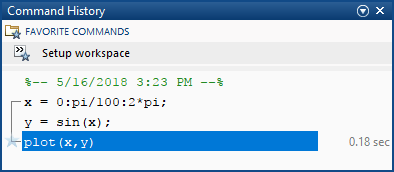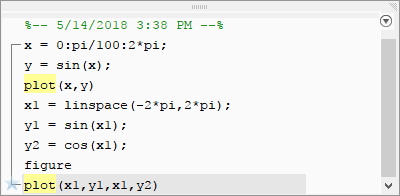命令历史记录
查看之前运行的语句
说明
命令历史记录显示您在当前和之前的 MATLAB® 会话中所运行的语句的记录。命令历史记录按操作系统的短日期格式列出每个会话的日期和时间,其后是该会话的语句。位于页面左侧一边的括号表示按组处理的语句。每个生成错误的语句组前面都有红色标记。
您可以在命令历史记录中选择条目,然后对所选条目执行下列操作。
操作 | 执行方式 |
|---|---|
根据语句创建脚本。 | 选择一个或多个条目,然后右键点击并从上下文菜单中选择创建脚本或创建实时脚本。编辑器或实时编辑器会打开一个新文件,其中包含您从命令历史记录中选择的语句。 |
重新运行以前的语句。 | 执行以下操作之一:
要扩大所选范围以包含多个语句,请按 Shift+↑。 |
将语句复制到另一个窗口。 | 选择一个或多个条目,然后执行以下操作之一:
|
根据语句创建一个收藏命令。 | 选择一个或多个条目,然后右键点击并选择新建收藏项。将打开“收藏命令编辑器”对话框,所选条目已添加到代码字段中。配置其他字段并点击保存。 有关收藏命令的详细信息,请参阅重新运行收藏命令。 |
删除条目。 | 选择要删除的条目,然后右击并选择删除,或按 Delete 键。 要删除所有条目,请点击操作按钮 ,然后从上下文菜单中选择清除命令历史记录。您不能重新调用以这种方式删除的条目。 |
打开 命令历史记录
您可以在命令行窗口的弹出窗口中查看命令历史记录,或将其停靠在“命令历史记录”面板中。
弹出窗口 - 要查看所有历史记录,请在命令行窗口中按向上箭头键 (↑)。要查看特定语句,请在提示符下键入该语句的任何部分,然后按向上箭头键。
命令历史记录弹出窗口在您处理所选语句后关闭。您也可以通过按 Esc 键关闭弹出窗口。要禁用弹出窗口,请转至主页选项卡,在环境部分中,点击布局。然后,在布局选项部分中,清除命令历史记录 > 弹出选项。
停靠 - 点击边栏上的命令历史记录图标 。如果边栏上没有命令历史记录图标,请点击“打开更多面板”按钮 并选择命令历史记录。也可以在命令行窗口中输入
commandhistory。
要更改 MATLAB 在命令历史记录中搜索结果的方式,请点击命令历史记录弹出窗口或面板中的操作按钮 ,并从可用选项中选择,这些选项包括从任意位置匹配、从头匹配和匹配大小写。有关其他设置的详细信息,请参阅修改命令历史记录设置。


